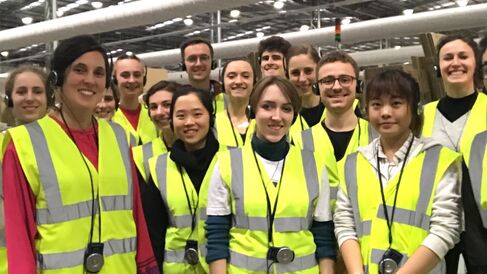Welcome to the Jungle: The Cruel Optimism of Amazon's Fulfilment Centres

Tom Mayer and Saide Mobayed from the MPhil Sociology programme reflect on a fieldtrip to the Amazon Fulfilment Centre in Peterborough.
We know. Time is the most valuable asset. Life gets busier and faster.
Yes, we also know that you have that deadline to meet, those 43 articles to read, and a bunch of friends to catch up with. And yes, we understand why it is more convenient to buy that new pair of curtains you so desperately need with one click rather than cycling to the city centre and waste the aforementioned valuable asset of yours: time.
But what does this simple click trigger? What sorts of redistributed means of action and assembled networks are produced after you place your order? What do the immediacy and over-yet-scarce materiality tell us about our current global political economy, power structures, or affective cultural circulations?
The Visit
In 2015—after a year of terrible press in 2014—Amazon decided to open its doors to the public for those who are curious, critical and/or sceptical about their extremely fast-paced and capitalised industry. Their “Fulfilment Centres”, a poignant name if we considered that their current capitalisation adds up to $755.7 billion, offer tours to “see the magic that happens after you click ‘buy'". Their main goal? To show us their “door-to-door” development. The Amazon Fulfilment Centre in Peterborough was opened in 2010. We made our way around the site wearing headphones that received our guide’s commentary. The experience was very capsular, detaching us somewhat from the reality we saw not a metre from where we were walking. At 550,000 ft2 this warehouse cannot be compared to the biggest one in the UK, which is over 2 million ft2. Our guide, who was very likeable and very good at his job, proudly informed us about their quick growth. Only in 2019, three centres were opened (all in the same week!). Reading that Amazon’s income tripled from $3 billion in 2017 to $10.1 billion in 2018 comes as no surprise.
The “Associates”
If only that outstanding growth would manifest in its workers’ wages or conditions: “associates”, as our guide called them (one of the many euphemisms big companies tend to give to their employees to maintain a fake horizontal and inclusive approach) earn £9.50/hour. They work 10 hours per day (four days a week) from which they can only take two breaks of 30 minutes per day (one of them is paid, the other is not). This means that “associates” stand on their feet for 9.30 hours every day with no natural air ventilation or light. We assume that is what is necessary for a warehouse of that dimension to be open 24 hours and 363 days of the year. In spite of these conditions, our guide was fully convinced—or at least he seemed to, or at least he was very good at conveying that to us—that working for Amazon was fabulously fun.
**A self-reflective note needs to be made before we continue any further. The fact that we are able to voice critical concerns about the Amazon Fulfilment Centre’s experience comes from a privileged standpoint. How many of us can actually decide what we want to do for a living? “Choose a job you love, and you will never have to work a day in your life” is nothing but a deceitful statement that capitalism has regurgitated over and over again to increase their profits whilst exploiting us. A logic of cruel optimism that has prevailed since the 1980s. Only a handful can decide to have “meaningful” or “satisfying” jobs**
The Objects
The process of purchase was explained in detail we could not have imagined. After an order is placed, the object enters a whirl of steps which sound technical and look four times more: inbound, stow, pick, pack (which was sold to us as something incredibly exciting and, in fact, there is a certain satisfaction from watching the mundanity of automatisation), SLAM (which stands for scan/label/apply/manifest), shipping and delivery. As easy linear and straight-forwarded as this sounds, life in that 550,000 ft2 seemed anything but simple. The number of logistical takes and the pace at which they should be achieved was just mesmerizing. But perhaps what was even more striking was the incommensurable amount of crap that is stored and accumulated along the hundreds of aisles. From children’s toys to mixers and winter boots, all of these daily objects carry with them a tracing code that is born the day we place our buy. That is the other fascinating element: the role of objects in every single part of the process. From the magic carry-it-all-the-time scanner to the lorry that transports tons of random things, it seems that we now live in a moment where objects determine our actions and not the other way around.
Conclusion
In conclusion, we would argue that visiting Amazing Fulfilment Centre poses various questions concerning the current state of capitalism, labour, affect, materiality, automatisation, technological improvement, amongst many others. Besides, this questioning is only one part of the massively convoluted and fractured global production chain behind everything we currently own, wear and eat. It takes only a couple of minutes for us to realise that everything we are wearing today is the product of contemporary forms of enslavement in countries like Vietnam, Bangladesh and China. Looking at the hundreds of steps and hands and sweat and logistics and frowns and ethics behind online shopping makes you think twice before clicking to buy those curtains you so desperately need.
